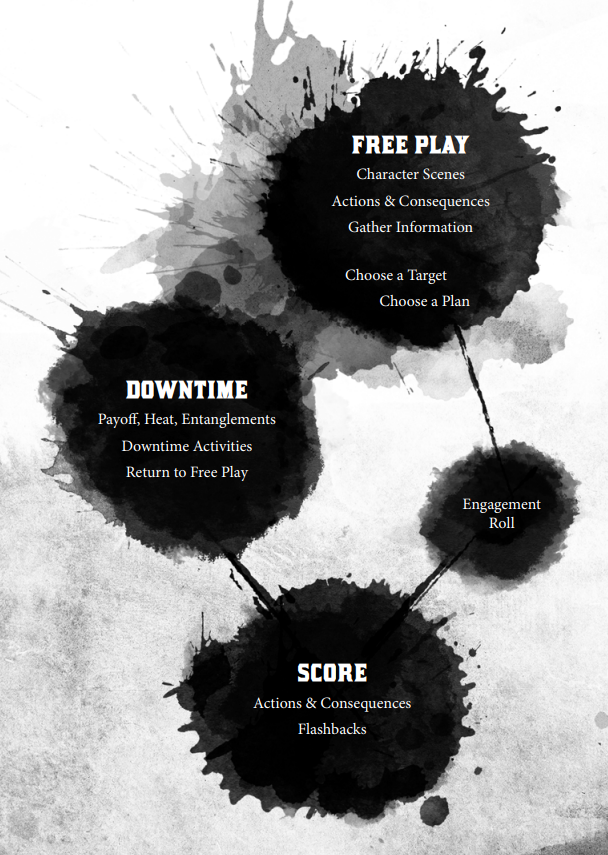39. Gathering Information - Not Just When We’re Told
“Can a player Gather Information during the score phase of Blades in the Dark?”
I asked that question yesterday when I finished asserting my theory that Gathering Information is part of a larger toolset of game actions focused on solidifying potential fiction into established fiction so that players may leverage it through play. The answer is I think a resounding “you could, but why would you want to”, which is my stance on Gathering Information (p36) as a sub-feature or mechanic of Blades in the Dark.
The Gather Information subsection on Page 36 does not talk about when the feature can be used, but the game structure diagram (and, I’d argue, the flow of Page 36) is pretty clear about design intent:
The Game Structure, Blades in the Dark, Page 9
Noting the eternal fuzziness of these ink splotches (and why is one of them a picture of my parents fighting?) the game clearly places Gather Information in the “post-downtime, pre-score” phase of play. Gather Information is, I’d propose, a tool for players to establish fiction that they can leverage in their choice of score. By learning where Avrick the powder dealer gets his supply (example of play on p36), we can then leverage the information that our old favourites the Red Sashes have a supply, and thus we can leverage it. Before establishing that fiction, players could not ensure that a score against the Red Sashes would yield the powder they want. The establishment of the fact gives us “Fictional Positioning” to begin the score process. More questions can be used then to assert more facts. This is key to the pre-score phase, because we as players have an obligation to “Choose a score” and “Choose a plan” (p9), and both of those require us to be able to link our short-, medium-, and long-term player goals with the current situation of Duskvol. If, as players, we look to our Turf and say “huh, personal clothier, +1d for social plans, that sounds cool!” We need a way to turn the potential fiction (that people get their clothes from somewhere) into established fiction (in Brightstone there is a clothier who is getting more and more sick of the Bluecoats shaking her down for money. We now have a location, a person, a gang, and a situation, against which players can leverage their character-constructs to achieve an aim.
So Gathering Information as a procedure defined by p36 - Ask, make an action roll or fortune roll, provide limited, standard, or great information, is a fine procedure fit for the nature of p36. So, if this works just fine, why is it possible but ill-advised to perform this during a score?
The answer is that frankly, it’s just not necessary. The procedure of the action roll communicates plenty, extracts information, and arguably could fully replace Gather Information at any time:
“1. The player states their goal for the action.
2. The player chooses the action rating.
3. The GM sets the position for the roll.
4. The GM sets the effect level for the action.
5. Add bonus dice.
6. The player rolls the dice and we judge the result.”
The action roll follows almost (but not quite) the structure for Gathering Information. In our Gather Information Clothier example, the crew first has to select a goal, and then present that to the GM. While “Is there a clothier around here?” may have been the question asked, the reality is that these questions hold an inherent reason to them “so that we might get them on our side” (or “so that we can steal something from them” “so that I can find a new vice purveyor”). Good Gathering Information requires that the question be framed by player goals and intent so that the fiction that is established is meaningful to the leverage the players intend to undertake (see yesterday’s comments on good PbtA questions lists for more on this).
The choice of action-rating is a part of the “who says what when” competition. Character-constructs have to have some way of measuring who gets priority in which situation [1], and we kind of have to shelf that entire conversation until we have time to unpack it.
[1] - This is actually a bigger thing about character-constructs, how they do and don’t reflect the character, and why we have the systems we do that present these constructs in the way they do. It’s way way way too big for this, and we’ll talk about it some day. The keyword for this problem is “+1D doesn’t mean anything, really.”
The GM sets the Position and Effect is, from my position, whether Gathering Information happens. If we consider Gathering Information to be a tool players use to extract leverageable fiction, then this is exactly what’s happening here. The GM has to establish facts about the fictional world and then categorise them in a way that players can leverage against: “We fight the Lampblack thugs!” “Because there’s six of them and three of you, and because they’re armed to the gills with clubs and pipes, your position is Desperate Limited”. Now we know all the established facts that give the Lampblacks power. We can summon up our own cohort of thugs through flashbacks or whatever, and then tell the GM “Well we’ve taken the numerical advantage off the table, and we’re all marking Pistols. So their arms advantage can fuck off too.”
The GM’s mandate, now is to respond to the shift in fiction. Blades in the Dark does not give them an opportunity to respond by re-establishing facts (or establishing new facts). Though there is space for clarification. By engaging with the goal and a fictional approach, we have forced the GM to show their cards, to make a play, in a way that we can then challenge it. That’s the essence of Gathering Information. The act of Gathering Information occurs, but not through a separate subsystem.
Which is perhaps why I’m cold on Gathering Information as a separate system per page 36. It either lacks the complexity to make it an interesting “action” to take on its own (as we see in Apocalypse World, where fiction interrogation is a move, and is as valid an action as an attack may be), but it also has this kind of weak systemitisation that we see in other approaches. The reason that the Action Roll generates such information clarity in a way that, say, a D&D 5e Attack Roll does not is because the procedure forces us to clarify and establish facts as we engage with it. The information is a result of fiction, and feeds back into fiction. Gather Information just doesn’t have that.
But Sidney (I hear you yell to your screen), Gather Information does have an action roll equivalent, surely that eases your contention. And my answer is absolutely not, because that’s shifting the information to being the result of the roll, not the act of process and fictional establishment. It’s why I’m equally unimpressed by “Make a Knowledge (History) roll + Intelligence” as a way of establishing fictional truths. One of the core elements of the Action Roll is RISK, which is absent from discussions in Gather Information (it talks about Obstacle, but not Risk, which is a fascinating shift).
The Risk of Gather Information is, from text, only ever information quality. You may roll low and therefor get limited information. Which is an horrendous shift back toward those early 2000s of 3.5ed D&D.
Remember that Gathering Information is about generating a situation that the PCs can leverage, which means we need to have a few things:
Something that is, or is in support of, the Player’s goals;
A fictional situation that provides an opportunity for the player characters;
A risk or implied consequence that makes it dramatic enough to worth playing in a game;
(All with enough fictional detail that players can interact with it through the systems of the game)
1 There is a clothier, who lives in Brightstone. 2 She is currently under the thumb of the Bluecoats, who take protection money, and 3 They’re been asking for more and more and she’s sick of their demands and their attitude.
1 There is a gang of Lampblacks. 2 There’s 6 of them, and they’re ready to fight. 3 There’s twice as many of them and they’re armed.
My argument is that the worst uses of Gathering Information as a subsystem don’t actually support the GM to do this! Instead it drives them toward a “detailed, complete, incomplete” waterfall of answers, as driven by dice instead of fictional exploration or endogenous procedure. I’d much rather see it resolved as an action roll:
Player says “I’m going to go find a clothier that would be amenable to becoming an asset of our gang”
GM decides they want this to be an Action Roll, so instead of just giving clear information back (Say yes, or roll dice), thinks quickly. Using my golden rule of Blades (“Everything is owned”) and decides the risk is that they may get found out just asking. Brightstone is where a lot of good stores are, and the bluecoats have an established presence there (Brightstone summary, page 259). So they say “Cool! There’s a Clothier in Brightstone that would be perfect for this. This is an action roll, the risk is that the people who already own this clothier find out, and you lose the element of surprise, maybe even get preemptive retribution.”
“Hey, I want to go find a clothier that we can get in our pocket” - Player sets the goal.
”I just want to wander around, keep my ear to the ground. Maybe buy the right well-dressed people some drinks. So I’ll use Consort” - Player sets the Action Rating (secondary to fiction)
”The Bluecoats are the ones that own the Clothier I’m thinking about. They’re a few tiers above you, so normally, stepping to them would be risky. On their turf, maybe desperate. But you’ve also got low heat and +1 status with them. If you keep asking the wrong questions though….let’s call it Risky.” - GM Sets Position
”But yeah, it’s no secret that they’re shaking people down, and it’s no secret that people hate it about them. And you’re asking probing questions. Great Effect.” - GM sets effect.
Now the interesting thing here is that we’ve already established the answer to the question. By going through the process, the player has their answer “Brightstone Clothier sick of Bluecoats” and the roll is simply to decide what dramatic and interesting fiction frames the heist[2]. As is the case with most Action Rolls. The risks and consequences (heat, +/- faction rep, whatever whatever) are the interesting part, built through the framing of the fiction (“What if instead of probing questions that would set of alarms, I just ask some surface stuff, framing it as a friendly chat, and we go for Controlled Standard instead?”) and endogenous applications of character-construct abilities (“I have a false identity, right? Can I reduce the risk if I pretend I’m asking for the Iron Lord?”).
[2] If the fact that Gathering Information is a relatively safe roll that doesn’t invoke dramatic fictional consequences is interesting to you, I feel like you and I play Blades for different reasons. I think that’s a point against it, if anything.
Gathering Information is already such a beautiful natural result of the act of Blades in the Dark’s negotation system. Having an additional subsystem that reduces the risk and introduces this really lame failure state where “ah the information is incomplete, guess you have to try again!” seems to miss the beauty of Blades in the Dark’s core resolution system.
Mark Experience,
Sidney Icarus
The header image: "Magnifying Glass" by emmacraig1 is licensed under CC BY 2.0.

